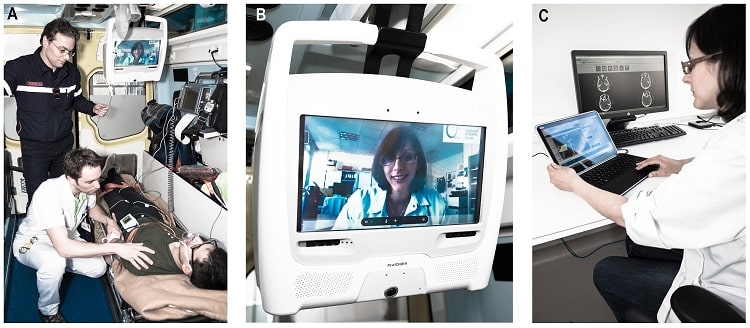Cross border telemedicine – Overview
The demand for healthcare is rising worldwide. Especially in the Western world, where the median age of the population is significantly growing.

Cross border telemedicine – Overview
This means that overcoming decades healthcare systems will have to face increasing numbers of people with chronic diseases.
The lack of trained professionals and uneven distribution of workforce make matters worse. Can cross-border telemedicine serve as a possible solution? Let’s find out.
What is cross-border telemedicine?
Telemedicine is defined as the provision of remote clinical services via electronic information and telecommunication technologies.
The term itself arose in the 1970s and is sometimes used interchangeably with ‘telehealth’. Its importance is growing along with the development of means of remote communication and the internet.
The patient and health professional can even be residing in different countries; e.g. radiologist in Germany interpreting your MRI image taken a few minutes ago in Greece. This is classified as cross-border telemedicine.
Different types of telemedicine practices:

Cross border telemedicine – Telemedicine Types
1. Teleconsultation – this is simply a remote communication session between you and your doctor.
2. Tele-expertise – happens between healthcare professionals and does not involve patients. Doctors may aid each other to come up with a diagnosis or treatment plan.
3. Tele-assistance – in this case, healthcare professionals remotely perform or supervise medical procedures.
4. Telemonitoring – mainly takes place outside the hospital and is used for patient follow-up.
The use of telemedicine within national systems is more or less common, but still limited, even less is known about cross-border practice.
Thus debates around this topic are mostly abstract. This relatively new phenomenon is almost exclusively represented by tele-expertise since other types of practices described above require interaction between patients and foreign doctors.
Most countries simply do not have an adapted legal framework for telemedicine.
What are the advantages of cross-border telemedicine?
Cross-border telemedicine offers to countries and geographical areas specialized healthcare not available before. This is especially important for developing countries.
The most important advantage is improved access to healthcare and closing the distance between qualified clinicians and patients in need. During teleconsultation or telemonitoring full-fledged audiovisual contact is established.
With the help of advanced video conferencing systems doctor and the patient can not only see and hear each other but also exchange printed and graphic data, such as blood test results, and X-ray films in real-time.
COVID-19 pandemic made this approach more appealing. Being so close and simultaneously so distant to patients has never been so useful before.
Another key advantage is the cost-effectiveness in long run. Introducing cross-border telemedicine providers as new players in the healthcare field will raise the quality and lower costs.
Telemedicine reduces travel time and expenses for patients as well as healthcare workers.
Apart from that, it will also substitute medical tourism at a certain level and this will have an additional positive effect on healthcare expenditures.
In addition, the expertise can serve as a valuable academic exchange and help to solve complicated cases.
What are the risks associated with cross-border telemedicine?
The first thing to consider is the quality of service. In the case of commercial platforms, it is hard for patients to check the qualification of caregivers behind the screen.
The lack of actual physical examination raises concerns even more, as long as some symptoms will be missed almost for sure.
Furthermore, standards of medical care sometimes differ between countries.
This has already caused problems for European hospitals that tried to cut costs by outsourcing diagnosis and using Asian platforms providing teleradiology services.
Another problem is the safety of personal data. As we have already mentioned, today cross border telemedicine is mainly represented by tele-expertise and most communications between healthcare professionals are informal, based on personal contacts.
Data protection and privacy can not be guaranteed without the proper platform.
Future and challenges for cross border telemedicine
In addition to the risks listed above, cross-border telemedicine providers should deal with the issue of liability.
Professional liability standards vary between medical specialties and countries as well. It is often unclear to both sides: the tele-experts and to the requesting physicians, who are responsible for the healthcare services provided.
Another huge challenge is communication in cross-border settings. Communicating parties can have trouble understanding each other and medical terminology.
Introducing staff for translation can be an option but will lead to more expenses.
Speaking of expenses, we have already mentioned that most likely cross border telemedicine services will be beneficial in long run, but in the short run, they cost much more to start than classic healthcare services.
The fact that most existing initiatives are pilot projects and have not reached unconditional success yet, does not make telemedicine an attractive field to invest money in.
In conclusion
Cross-border telemedicine will not replace classic healthcare services in near future. But its value in some specific circumstances will rise: these include the lack of highly specialized experts in the country, and the treatment of rare diseases, which require multidisciplinary consultation.
References:
See Also
Telemedicine Equipment Types

As a nutritionist, I research, find and experiment with recipes, natural diets and meal plans for weight loss, bodybuilding, and detoxing.
